

Compact Muon Solenoid
LHC, CERN
| CMS-PAS-BPH-21-004 | ||
| Observation of triple $\mathrm{J}\psi$ meson production in proton-proton collisions at $\sqrt{s} = $ 13 TeV | ||
| CMS Collaboration | ||
| July 2021 | ||
| Abstract: The first observation of the combined production of three $\mathrm{J}\psi$ mesons in proton-proton collisions at a center-of-mass energy of 13 TeV is reported. The analysis is based on a data sample recorded by the CMS experiment at the CERN LHC corresponding to an integrated luminosity of 133 fb$^{-1}$. The search for triple-$\mathrm{J}\psi$ production is performed in final states with three $\mu^{+}\mu^{-}$ pairs that pass fiducial kinematic criteria chosen so as to select high-$p_\mathrm{T}$ $\mathrm{J}\psi$ mesons produced at midrapidity. The $\mathrm{pp}\to\mathrm{J}\psi\,\mathrm{J}\psi\,\mathrm{J}\psi\,\mathrm{X}$ process is observed with a significance in excess of five standard deviations. The fiducial cross section for this process is found to be $\sigma(\mathrm{pp}\to\mathrm{J}\psi\,\mathrm{J}\psi\,\mathrm{J}\psi\,\mathrm{X})= $ 272$^{+141}_{-104}$ (stat) $\pm$ 17 (syst) fb. The result is compared to theoretical expectations for the production of three $\mathrm{J}\psi$ mesons in single (SPS), double- (DPS), and triple- (TPS) parton scattering processes. Under the most economical assumption of factorization of multiple hard scattering probabilities in terms of SPS cross sections, the measured final state is found to be dominated by DPS and TPS contributions. A value of the associated DPS effective cross section parameter of $\sigma_\mathrm{eff,DPS} = $ 2.7$^{+1.4}_{-1.0}$ (exp) $^{+1.5}_{-1.0}$ (theo) mb, related to the transverse distribution of partons in the proton, is derived. | ||
|
Links:
CDS record (PDF) ;
CADI line (restricted) ;
These preliminary results are superseded in this paper, NP 19 (2023) 338. The superseded preliminary plots can be found here. |
||
| Figures | |
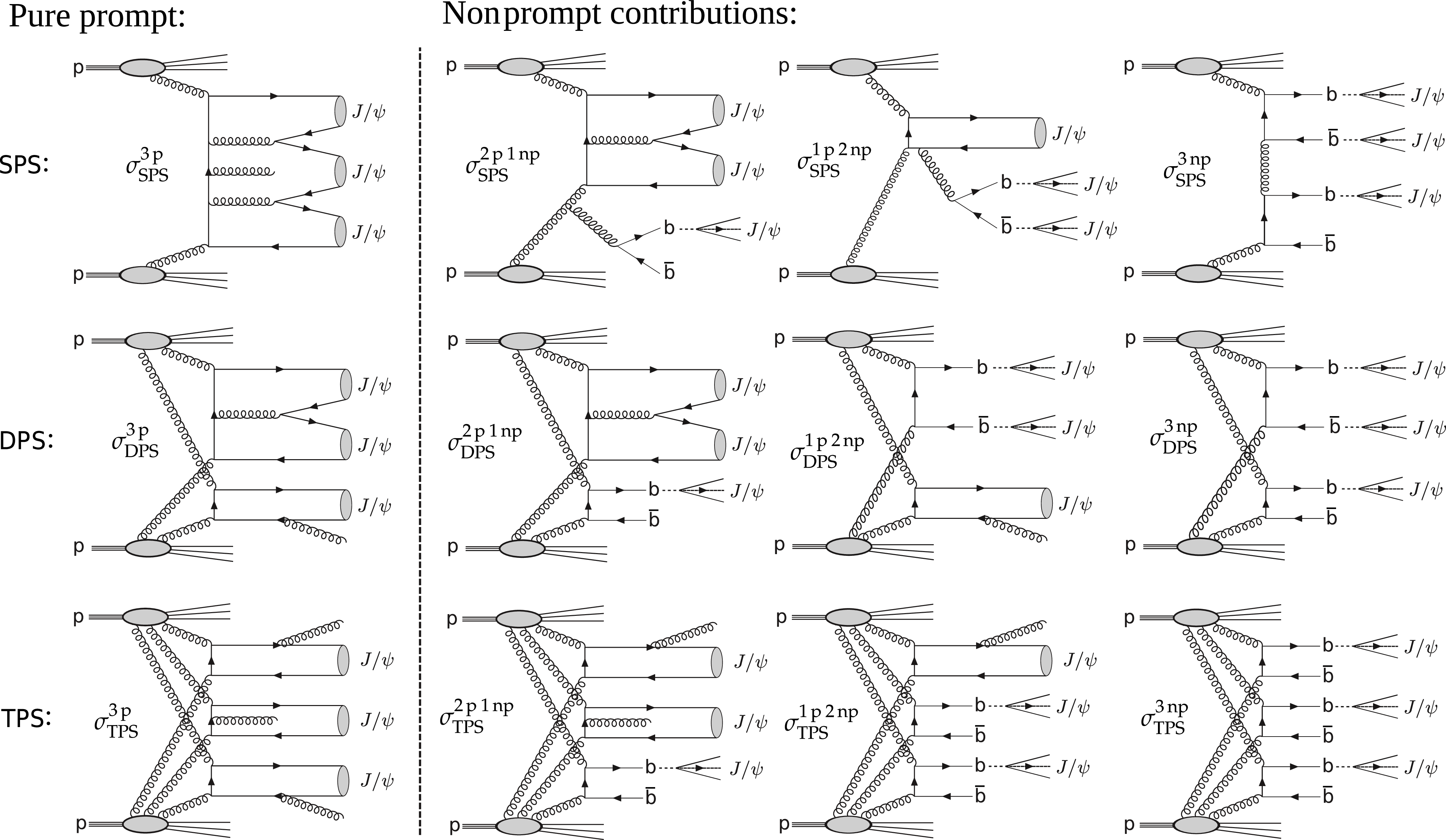
png pdf |
Figure 1:
Leading diagrams for triple-${\mathrm{J}/\psi}$ production in ${\mathrm{p}} {\mathrm{p}} $ collisions via single- (upper), double- (middle), and triple- (lower) parton scatterings. The leftmost diagrams show the triple prompt-${\mathrm{J}/\psi}$ processes. The remaining diagrams show (left to right) final states with increasing contributions of nonprompt ${\mathrm{J}/\psi}$ 's from B meson decays. The symbols $\sigma ^\mathrm {IpJnp}_\mathrm {NPS}$ are provided to identify each prompt (p) and/or nonprompt (np) diagram to its associated cross section discussed below. |

png pdf |
Figure 2:
Invariant mass distributions for the three ${\mathrm{J}/\psi}$ muon pairs, ordered (left to right) by increasing transverse momentum of the $\mu^{+} \mu^{-} $ system. In each panel, the data are represented by the points, with the vertical bars showing the statistical uncertainties, the solid curve the overall fit to the data and the dashed curve the widened sideband window. The shaded region corresponds to the fitted signal yield. |
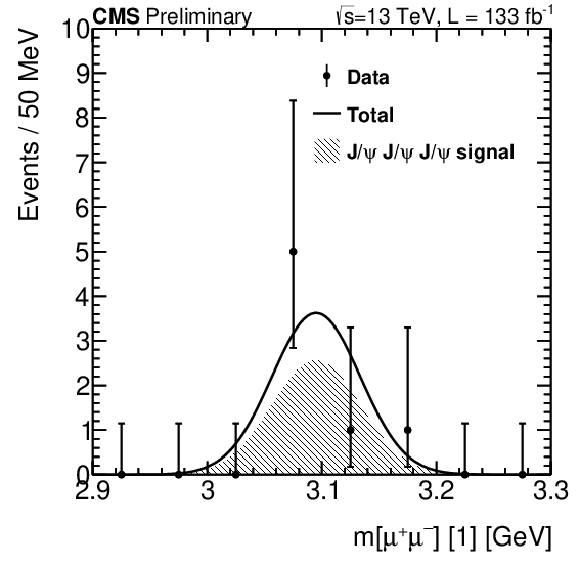
png pdf |
Figure 2-a:
Invariant mass distributions for the three ${\mathrm{J}/\psi}$ muon pairs, ordered (left to right) by increasing transverse momentum of the $\mu^{+} \mu^{-} $ system. In each panel, the data are represented by the points, with the vertical bars showing the statistical uncertainties, the solid curve the overall fit to the data and the dashed curve the widened sideband window. The shaded region corresponds to the fitted signal yield. |
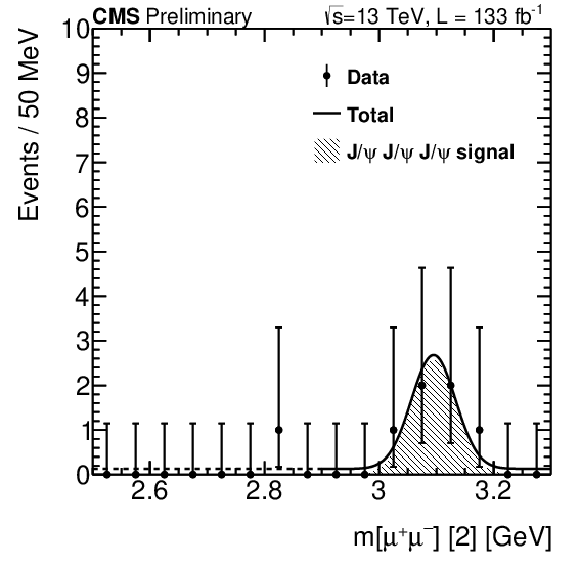
png pdf |
Figure 2-b:
Invariant mass distributions for the three ${\mathrm{J}/\psi}$ muon pairs, ordered (left to right) by increasing transverse momentum of the $\mu^{+} \mu^{-} $ system. In each panel, the data are represented by the points, with the vertical bars showing the statistical uncertainties, the solid curve the overall fit to the data and the dashed curve the widened sideband window. The shaded region corresponds to the fitted signal yield. |
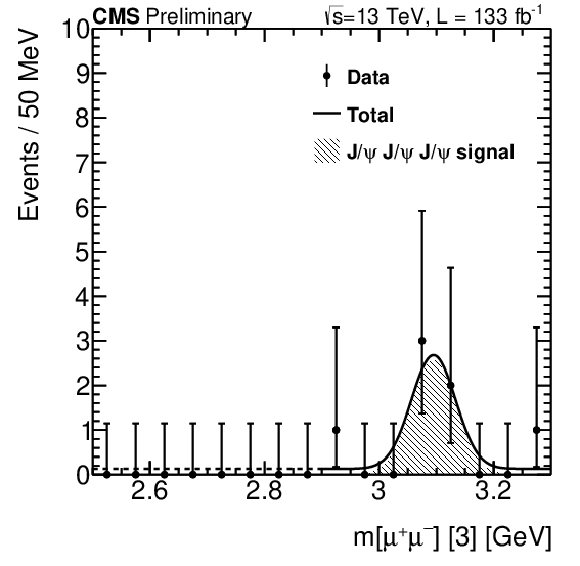
png pdf |
Figure 2-c:
Invariant mass distributions for the three ${\mathrm{J}/\psi}$ muon pairs, ordered (left to right) by increasing transverse momentum of the $\mu^{+} \mu^{-} $ system. In each panel, the data are represented by the points, with the vertical bars showing the statistical uncertainties, the solid curve the overall fit to the data and the dashed curve the widened sideband window. The shaded region corresponds to the fitted signal yield. |
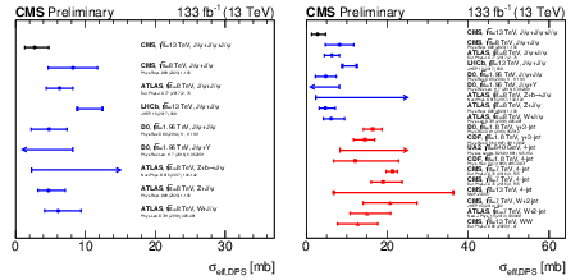
png pdf |
Figure 3:
Comparison of the effective DPS cross sections $ {\sigma _\mathrm {eff,DPS}} $ extracted in this work (top data point in both panels) to the same parameter derived in measurements of double-quarkonium and electroweak boson plus quarkonium production [10,59,13,58,12,60,61] alone (left), as well as also in final states with jets [54,55,7,23], $\gamma +$jets [56,57], $\mathrm{W} +$jets [17,18], and same-sign W bosons [22] (right). |
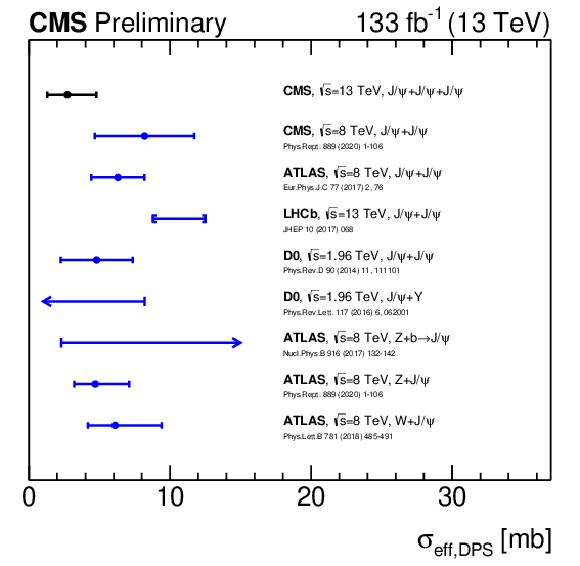
png pdf |
Figure 3-a:
Comparison of the effective DPS cross sections $ {\sigma _\mathrm {eff,DPS}} $ extracted in this work (top data point in both panels) to the same parameter derived in measurements of double-quarkonium and electroweak boson plus quarkonium production [10,59,13,58,12,60,61] alone (left), as well as also in final states with jets [54,55,7,23], $\gamma +$jets [56,57], $\mathrm{W} +$jets [17,18], and same-sign W bosons [22] (right). |
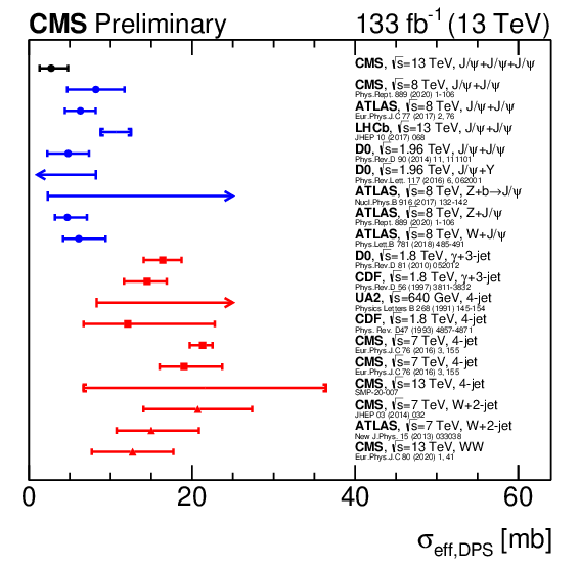
png pdf |
Figure 3-b:
Comparison of the effective DPS cross sections $ {\sigma _\mathrm {eff,DPS}} $ extracted in this work (top data point in both panels) to the same parameter derived in measurements of double-quarkonium and electroweak boson plus quarkonium production [10,59,13,58,12,60,61] alone (left), as well as also in final states with jets [54,55,7,23], $\gamma +$jets [56,57], $\mathrm{W} +$jets [17,18], and same-sign W bosons [22] (right). |
| Tables | |

png pdf |
Table 1:
Definition of the fiducial phase space for the triple-${\mathrm{J}/\psi}$ cross section measurement. |
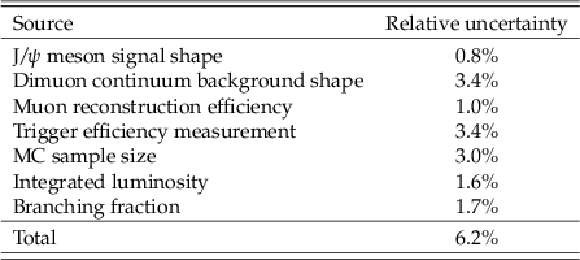
png pdf |
Table 2:
Contributions to the systematic uncertainty of the $\sigma ({\mathrm{p}} {\mathrm{p}} \to {\mathrm{J}/\psi} \, {\mathrm{J}/\psi} \, {\mathrm{J}/\psi} \, \mathrm {X})$ measurement, in percent. The last row gives the sum in quadrature of all components. |

png pdf |
Table 3:
Predictions for single-, double-, and triple-${\mathrm{J}/\psi}$ production cross sections in SPS processes, which pass the fiducial criteria listed in Table 1, derived from the HELAC-Onia (ho) and MadGraph 5\_amc@nlo (mg5nlo) matrix element calculators, complemented with the PYTHIA 8 (py8) parton shower, as described in the text. |
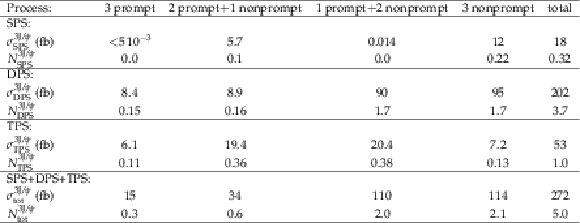
png pdf |
Table 4:
Central predictions for triple-${\mathrm{J}/\psi}$ production cross sections and yields from SPS, DPS (for $ {\sigma _\mathrm {eff,DPS}} = $ 2.7 mb), and TPS (for $ {\sigma _\mathrm {eff,TPS}} =$ 0.82, $ {\sigma _\mathrm {eff,DPS}} = $ 2.2 mb) processes, and their sums. The DPS and TPS results are derived via Eqs. (3) and (4) from the SPS cross sections listed in Table 3 with $ {\sigma _\mathrm {eff,DPS}} $ chosen so that the sum of contributions yields a total cross section equal to the experimental value of $\sigma ^{3{\mathrm{J}/\psi}}_\mathrm {tot}$. The expected yield, $N^{3{\mathrm{J}/\psi}}_\mathrm {NPS}$, is given for $\varepsilon \, {\mathcal {L}} _\mathrm {int}=$ 87 fb$^{-1} $ for each contributing process. The last column lists the total DPS and TPS cross sections and yields. |
| Summary |
| The first observation of the concurrent production of three ${\mathrm{J}/\psi}$ mesons in proton-proton collisions at $\sqrt{s} = $ 13 TeV has been reported. Events with three ${\mathrm{J}/\psi}$ mesons, each decaying into two muons, have been reconstructed including prompt as well as nonprompt (i.e., coming from B decays) production. After all selection requirements, five events are found that are consistent with triple-${\mathrm{J}/\psi}$ production, plus one event assigned to possible combinatorial background, through a three-dimensional unbinned extended maximum likelihood fit of the dimuons invariant mass distributions. The statistical significance of the signal relative to the background-only expectation corresponds to a significance above five standard deviations. The cross section for triple-${\mathrm{J}/\psi}$ production, within the fiducial region defined in Table 1, is $\sigma(\mathrm{pp}\to{\mathrm{J}/\psi}\,{\mathrm{J}/\psi}\,{\mathrm{J}/\psi} \,\mathrm{X})= $ 272$^{+141}_{-104}$ (stat) $\pm$ 17 (syst) fb. This result is compared to the theoretical expectations for triple-${\mathrm{J}/\psi}$ production via a sum of contributions from single- (SPS), double- (DPS), and triple- (TPS) parton scatterings. Under the most economical assumption of factorization of multiple hard scattering probabilities in terms of SPS cross sections, the measured triple-${\mathrm{J}/\psi}$ cross section is consistent with the production via DPS ($\sim$74%), TPS ($\sim$20%), and SPS ($\sim$6%) processes for a value of the effective DPS cross section parameter, closely related to the transverse distribution of partons in the proton, of $ \sigma_\mathrm{eff,DPS} = $ 2.7$ ^{+1.4}_{-1.0}$ (exp) $^{+1.5}_{-1.0}$ (theo) mb. Within its large uncertainty, this value is consistent with similarly extracted parameters from double-quarkonium measurements, but significantly smaller than the effective DPS cross sections derived from double-particle final states that include high-$p_{\mathrm{T}}$ jets, photons, and electroweak bosons. The present analysis provides a novel approach to study multiple hard scatterings in pp collisions exploiting, for the first time, the production of three heavy particles. |
| References | ||||
| 1 | M. Diehl, D. Ostermeier, and A. Schafer | Elements of a theory for multiparton interactions in QCD | JHEP 03 (2012) 089 | 1111.0910 |
| 2 | P. Bartalini and J. R. Gaunt, eds. | Multiple Parton Interactions at the LHC | volume 29 WSP, 2019 , ISBN 978-981-322-775-0, 978-981-322-777-4 | |
| 3 | D. d'Enterria and A. Snigirev | Double, triple, and $ n $-parton scatterings in high-energy proton and nuclear collisions | Adv. Ser. Direct. High Energy Phys. 29 (2018) 159 | 1708.07519 |
| 4 | E. Chapon et al. | Perspectives for quarkonium studies at the high-luminosity LHC | Prog. Part. NP (2021) to appear | 2012.14161 |
| 5 | T. Sjostrand | The development of MPI modeling in PYTHIA | Adv. Ser. Direct. High Energy Phys. 29 (2019) 191 | 1706.02166 |
| 6 | M. H. Seymour and A. Siodmok | Constraining MPI models using $ \sigma_\mathrm{eff} $ and recent Tevatron and LHC underlying event data | JHEP 10 (2013) 113 | 1307.5015 |
| 7 | CMS Collaboration | Event generator tunes obtained from underlying event and multiparton scattering measurements | EPJC 76 (2016) 155 | CMS-GEN-14-001 1512.00815 |
| 8 | B. Blok and M. Strikman | Multiparton pp and pA collisions: From geometry to parton-parton correlations | Adv. Ser. Direct. High Energy Phys. 29 (2018) 63 | 1709.00334 |
| 9 | LHCb Collaboration | Observation of J$ /\psi $ pair production in pp collisions at $ \sqrt{s}= $ 7 TeV | PLB 707 (2012) 52 | 1109.0963 |
| 10 | D0 Collaboration | Observation and studies of double J$ /\psi $ production at the Tevatron | PRD 90 (2014) 111101 | 1406.2380 |
| 11 | CMS Collaboration | Measurement of prompt J$ /\psi $ pair production in pp collisions at $ \sqrt{s} = $ 7 TeV | JHEP 09 (2014) 094 | CMS-BPH-11-021 1406.0484 |
| 12 | ATLAS Collaboration | Measurement of the prompt J$ /\psi $ pair production cross-section in pp collisions at $ \sqrt{s} = $ 8 TeV with the ATLAS detector | EPJC 77 (2017) 76 | 1612.02950 |
| 13 | LHCb Collaboration | Measurement of the J$ /\psi $ pair production cross-section in pp collisions at $ \sqrt{s}= $ 13 TeV | JHEP 06 (2017) 047 | 1612.07451 |
| 14 | D0 Collaboration | Evidence for simultaneous production of J$ /\psi $ and $ \Upsilon $ mesons | PRL 116 (2016) 082002 | 1511.02428 |
| 15 | CMS Collaboration | Observation of $ \Upsilon $(1S) pair production in proton-proton collisions at $ \sqrt{s}= $ 8 TeV | JHEP 05 (2017) 013 | CMS-BPH-14-008 1610.07095 |
| 16 | CMS Collaboration | Measurement of the $ \Upsilon $(1S) pair production cross section and search for resonances decaying to $ \Upsilon $(1S)$ \mu^+\mu^- $ in proton-proton collisions at $ \sqrt{s} = $ 13 TeV | PLB 808 (2020) 135578 | CMS-BPH-18-002 2002.06393 |
| 17 | ATLAS Collaboration | Measurement of hard double-parton interactions in W$ (\to l\nu) $+ 2 jet events at $ \sqrt{s} = $ 7 TeV with the ATLAS detector | New J. Phys. 15 (2013) 033038 | 1301.6872 |
| 18 | CMS Collaboration | Study of double parton scattering using W + 2-jet events in proton-proton collisions at $ \sqrt{s} = $ 7 TeV | JHEP 03 (2014) 032 | CMS-FSQ-12-028 1312.5729 |
| 19 | ATLAS Collaboration | Study of hard double-parton scattering in four-jet events in pp collisions at $ \sqrt{s}= $ 7 TeV with the ATLAS experiment | JHEP 11 (2016) 110 | 1608.01857 |
| 20 | CMS Collaboration | Constraints on the double-parton scattering cross section from same-sign W boson pair production in proton-proton collisions at $ \sqrt{s}= $ 8 TeV | JHEP 02 (2018) 032 | CMS-FSQ-16-005 1712.02280 |
| 21 | ATLAS Collaboration | Study of the hard double-parton scattering contribution to inclusive four-lepton production in pp collisions at $ \sqrt{s}= $ 8 TeV with the ATLAS detector | PLB 790 (2019) 595 | 1811.11094 |
| 22 | CMS Collaboration | Evidence for WW production from double-parton interactions in proton-proton collisions at $ \sqrt{s} = $ 13 TeV | EPJC 80 (2020) 41 | CMS-SMP-18-015 1909.06265 |
| 23 | CMS Collaboration | Study of double-parton scattering in the inclusive production of four jets with low transverse momentum in proton-proton collisions at $ \sqrt{s} = $ 13 TeV | CMS-PAS-SMP-20-007 | |
| 24 | D. d'Enterria and A. M. Snigirev | Triple parton scatterings in high-energy proton-proton collisions | PRL 118 (2017) 122001 | 1612.05582 |
| 25 | H.-S. Shao and Y.-J. Zhang | Triple prompt J$ /\psi $ hadroproduction as a hard probe of multiple-parton scatterings | PRL 122 (2019) 192002 | 1902.04949 |
| 26 | H.-S. Shao | HELAC-Onia: An automatic matrix element generator for heavy quarkonium physics | CPC 184 (2013) 2562 | 1212.5293 |
| 27 | H.-S. Shao | HELAC-Onia 2.0: an upgraded matrix-element and event generator for heavy quarkonium physics | CPC 198 (2016) 238 | 1507.03435 |
| 28 | CMS Collaboration | The CMS experiment at the CERN LHC | JINST 3 (2008) S08004 | CMS-00-001 |
| 29 | CMS Collaboration | Performance of the CMS Level-1 trigger in proton-proton collisions at $ \sqrt{s} = $ 13 TeV | JINST 15 (2020) P10017 | CMS-TRG-17-001 2006.10165 |
| 30 | CMS Collaboration | The CMS trigger system | JINST 12 (2017) P01020 | CMS-TRG-12-001 1609.02366 |
| 31 | R. Fruhwirth | Application of Kalman filtering to track and vertex fitting | NIMA 262 (1987) 444 | |
| 32 | CMS Collaboration | Performance of the CMS muon detector and muon reconstruction with proton-proton collisions at $ \sqrt{s}= $ 13 TeV | JINST 13 (2018) P06015 | CMS-MUO-16-001 1804.04528 |
| 33 | CMS Collaboration | Particle-flow reconstruction and global event description with the CMS detector | JINST 12 (2017) P10003 | CMS-PRF-14-001 1706.04965 |
| 34 | M. Cacciari, G. P. Salam, and G. Soyez | The anti-$ {k_{\mathrm{T}}} $ jet clustering algorithm | JHEP 04 (2008) 063 | 0802.1189 |
| 35 | M. Cacciari, G. P. Salam, and G. Soyez | FastJet user manual | EPJC 72 (2012) 1896 | 1111.6097 |
| 36 | Particle Data Group Collaboration | Review of particle physics | PRD 98 (2018) 030001 | |
| 37 | GEANT4 Collaboration | GEANT4--a simulation toolkit | NIMA 506 (2003) 250 | |
| 38 | CMS Collaboration | Prompt and non-prompt J$ /\psi $ production in pp collisions at $ \sqrt{s}= $ 7 TeV | EPJC 71 (2011) 1575 | CMS-BPH-10-002 1011.4193 |
| 39 | CMS Collaboration | J$ /\psi $ and $ \psi $(2S) production in pp collisions at $ \sqrt{s}= $ 7 TeV | JHEP 02 (2012) 011 | CMS-BPH-10-014 1111.1557 |
| 40 | CMS Collaboration | Measurement of J/$ \psi $ and $ \psi(2S) $ prompt double-differential cross sections in pp collisions at $ \sqrt{s}= $ 7 TeV | PRL 114 (2015) 191802 | CMS-BPH-14-001 1502.04155 |
| 41 | CMS Collaboration | Measurement of prompt and nonprompt J$ /{\psi} $ production in $ \mathrm {p}\mathrm{p} $ and $ \mathrm{p}\mathrm {Pb} $ collisions at $ \sqrt{s_{\mathrm {NN}}} = $ 5.02 TeV | EPJC 77 (2017) 269 | CMS-HIN-14-009 1702.01462 |
| 42 | G. Cowan, K. Cranmer, E. Gross, and O. Vitells | Asymptotic formulae for likelihood-based tests of new physics | EPJC 71 (2011) 1554 | 1007.1727 |
| 43 | S. S. Wilks | The large-sample distribution of the likelihood ratio for testing composite hypotheses | Annals Math. Statist. 9 (1938) 60 | |
| 44 | M. Pivk and F. R. Le Diberder | SPlot: A statistical tool to unfold data distributions | NIMA 555 (2005) 356 | physics/0402083 |
| 45 | CMS Collaboration | Precision luminosity measurement in proton-proton collisions at $ \sqrt{s} = $ 13 TeV in 2015 and 2016 at CMS | Submitted to EPJC | CMS-LUM-17-003 2104.01927 |
| 46 | J.-P. Lansberg and H.-S. Shao | Production of J$ /\psi + \eta_{c} $ versus J$ /\psi + \mathrm{J}/\psi $ at the LHC: Importance of real $ \alpha^{5}_{s} $ corrections | PRL 111 (2013) 122001 | 1308.0474 |
| 47 | J.-P. Lansberg and H.-S. Shao | J/$ \psi $ -pair production at large momenta: Indications for double parton scatterings and large $ \alpha _s^5 $ contributions | PLB 751 (2015) 479 | 1410.8822 |
| 48 | J.-P. Lansberg and H.-S. Shao | Towards an automated tool to evaluate the impact of the nuclear modification of the gluon density on quarkonium, D and B meson production in proton-nucleus collisions | EPJC 77 (2017) 1 | 1610.05382 |
| 49 | ATLAS Collaboration | Measurement of the differential cross-sections of prompt and non-prompt production of J/$ \psi $ and $ \psi (2\mathrm {S}) $ in pp collisions at $ \sqrt{s} = $ 7 and 8 TeV with the ATLAS detector | EPJC 76 (2016) 283 | 1512.03657 |
| 50 | J. Alwall et al. | The automated computation of tree-level and next-to-leading order differential cross sections, and their matching to parton shower simulations | JHEP 07 (2014) 079 | 1405.0301 |
| 51 | S. Dulat et al. | New parton distribution functions from a global analysis of quantum chromodynamics | PRD 93 (2016) 033006 | 1506.07443 |
| 52 | H.-S. Shao | J/$ {\psi} $ meson production in association with an open charm hadron at the LHC: A reappraisal | PRD 102 (2020) 034023 | 2005.12967 |
| 53 | ATLAS Collaboration | Observation and measurements of the production of prompt and non-prompt J$ /\psi $ mesons in association with a Z boson in pp collisions at $ \sqrt{s} = $ 8 TeV with the ATLAS detector | EPJC 75 (2015) 229 | 1412.6428 |
| 54 | UA2 Collaboration | A study of multi-jet events at the CERN $ \mathrm{\overline{p}p} $ collider and a search for double parton scattering | PLB 268 (1991) 145 | |
| 55 | CDF Collaboration | Study of four jet events and evidence for double parton interactions in $ \mathrm{\overline{p}p} $ collisions at $ \sqrt{s} = $ 1.8 TeV | PRD 47 (1993) 4857 | |
| 56 | CDF Collaboration | Double parton scattering in $ \mathrm{\overline{p}p} $ collisions at $ \sqrt{s} = $ 1.8 TeV | PRD 56 (1997) 3811 | |
| 57 | D0 Collaboration | Double parton interactions in $ \gamma $+3 jet events in $ \mathrm{\overline{p}p} $ collisions $ \sqrt{s}= $ 1.96 TeV | PRD 81 (2010) 052012 | 0912.5104 |
| 58 | J.-P. Lansberg and H.-S. Shao | Phenomenological analysis of associated production of $ \mathrm{Z^0+b} $ in the $ \mathrm{b} \rightarrow \mathrm{J}/\psi\mathrm{X} $ decay channel at the LHC | NPB 916 (2017) 132 | 1611.09303 |
| 59 | H.-S. Shao and Y.-J. Zhang | Complete study of hadroproduction of a $ \Upsilon $ meson associated with a prompt $ \mathrm{J}/\psi $ | PRL 117 (2016) 062001 | 1605.03061 |
| 60 | J.-P. Lansberg, H.-S. Shao, and N. Yamanaka | Indication for double parton scatterings in $ \mathrm{W}^+ $ prompt J$ /\psi $ production at the LHC | PLB 781 (2018) 485 | 1707.04350 |
| 61 | J.-P. Lansberg | New observables in inclusive production of quarkonia | PR 889 (2020) 1 | 1903.09185 |

|
Compact Muon Solenoid LHC, CERN |

|

|

|

|

|

|